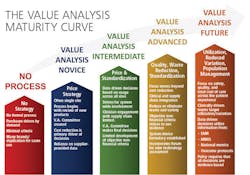Navigating around, through the Value Analysis Maturity Curve
As healthcare reform and new technologies change the way hospitals deliver and are reimbursed for care, the ability to measure and improve upon patient outcomes is becoming more important than ever. To ensure these efforts are successful, hospitals must be able to evaluate and improve the maturity of the various value analysis processes at work within their organization and at an enterprise level, which includes clinics and extended care.
To do that, hospitals must first understand where they exist on a Value Analysis Maturity spectrum. Then, they must increasingly engage leadership and clinicians to operationalize best practices.
The result is a culture of truly collaborative, evidence-based decision-making, resulting in the only metric that really matters: Improving quality of care, and thus the overall health of the community being served.
At its heart, value analysis is a framework for making better decisions. Those decisions are meant to balance the needs of multiple constituents in the healthcare delivery system: Patients, physicians, payers, administrative and clinical staff. But the basic function of any Value Analysis team or process is to support clinical committees with a framework that assists with evaluating the planned introduction of products, services, and technology into the portfolio of care. The goal is to drive measurable improvements in outcome. Depending upon an individual committee or facility’s maturity, value analysis does that by providing clinical committees with clear charters, policies, evidence-based decision-making procedures, key performance indicators and on-going measurement.
In mature facilities and committees, the physicians/providers/clinicians support and endorse the end result of this process, and can apply not just the final result of any individual decision, but also the decision-making framework itself, to their daily routine.
Value Analysis teams, who are tasked with evaluating requests for new technologies, while reining in costs and simultaneously improving outcomes, are at the (stressful) center of a process beset by shifting market forces.
The process is stressful for several reasons:
The process is political: For years, the VA team existed to approve new product requests and, let’s face it, to keep the physician happy.
The process is high-visibility and accountable for cost reductions: Because VA teams have been tasked by hospital leadership with reducing costs and standardizing products, in part due to a growing awareness that value-based medicine, which is on the horizon, will change how things are done. Because of this, physicians have come to see the VA and Purchasing teams as gatekeepers, increasing stress for everyone.
To successfully navigate these pressures, hospitals must operationalize best practices in value analysis throughout the location of care — replicating successful decision-making frameworks that improve patient care, standardize technologies, procedures, and products like implants and med/surg devices, while simultaneously providing enough flexibility to accommodate variability in individual patient circumstances and indications.
Before you can improve your value analysis process, it’s important to understand how mature the framework is within your organization. A project was conducted by the Strategic Marketplace Initiative (SMI) and the Association for Healthcare Value Analysis Professionals (AHVAP) defining the following value analysis maturity curve.
Advanced and best practices have developed guidance documents and automated frameworks that help provide structure around what indications and patient populations a medical technology will be used. By focusing on improvements in care, overall costs are also reduced, sometimes dramatically. The goals of the stakeholders in this stage are now the same rather than divergent. This represents the true clinical integration of supply chain and value analysis processes.
The maturity of value analysis is a result of cultural, financial and clinical considerations. And when that happens, truly innovative advances in how to evaluate technology’s impact upon patient care, profitability and outcomes becomes possible.

Dee Donatelli
Dee Donatelli, R.N., CMRP, CVAHP, has more than 40 years of experience in the healthcare industry as a registered nurse, supply chain executive and consultant. Donatelli has held leadership positions in hospitals, consulting firms, distributors and GPOs. Donatelli is a past president of the Association of Healthcare Value Analysis Professionals (AHVAP) and is Chair-elect of the Association for Healthcare Resource and Materials Management (AHRMM). An Bellwether Class of 2015 inductee, she also serves on Bellwether League’s Board of Directors. Donatelli currently serves as Vice President, Professional Services, at TractManager and as Principal, Dee Donatelli Consulting, LLC. She is a member of Healthcare Purchasing News’ Editorial Advisory Board and can be reached at [email protected].






